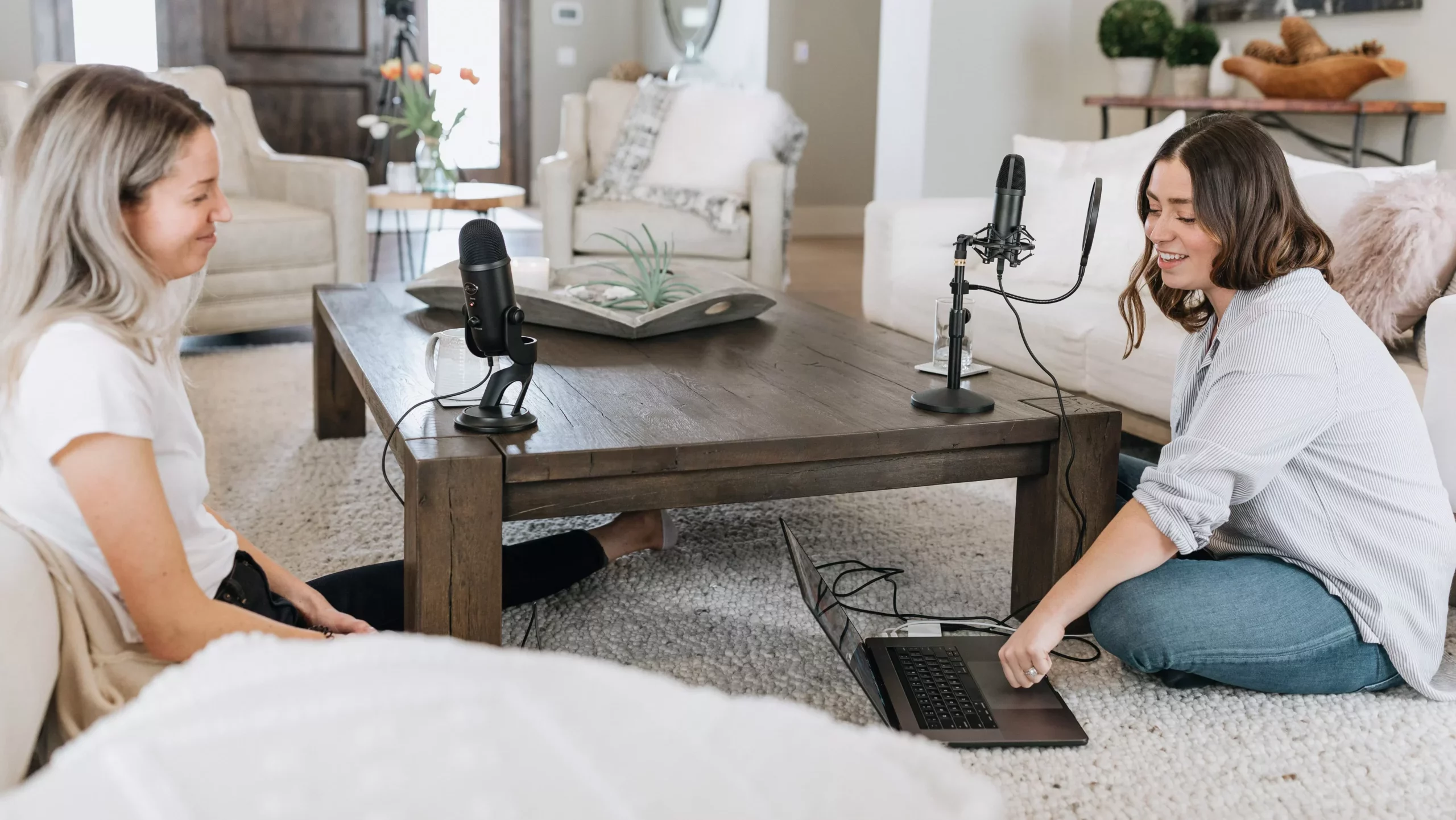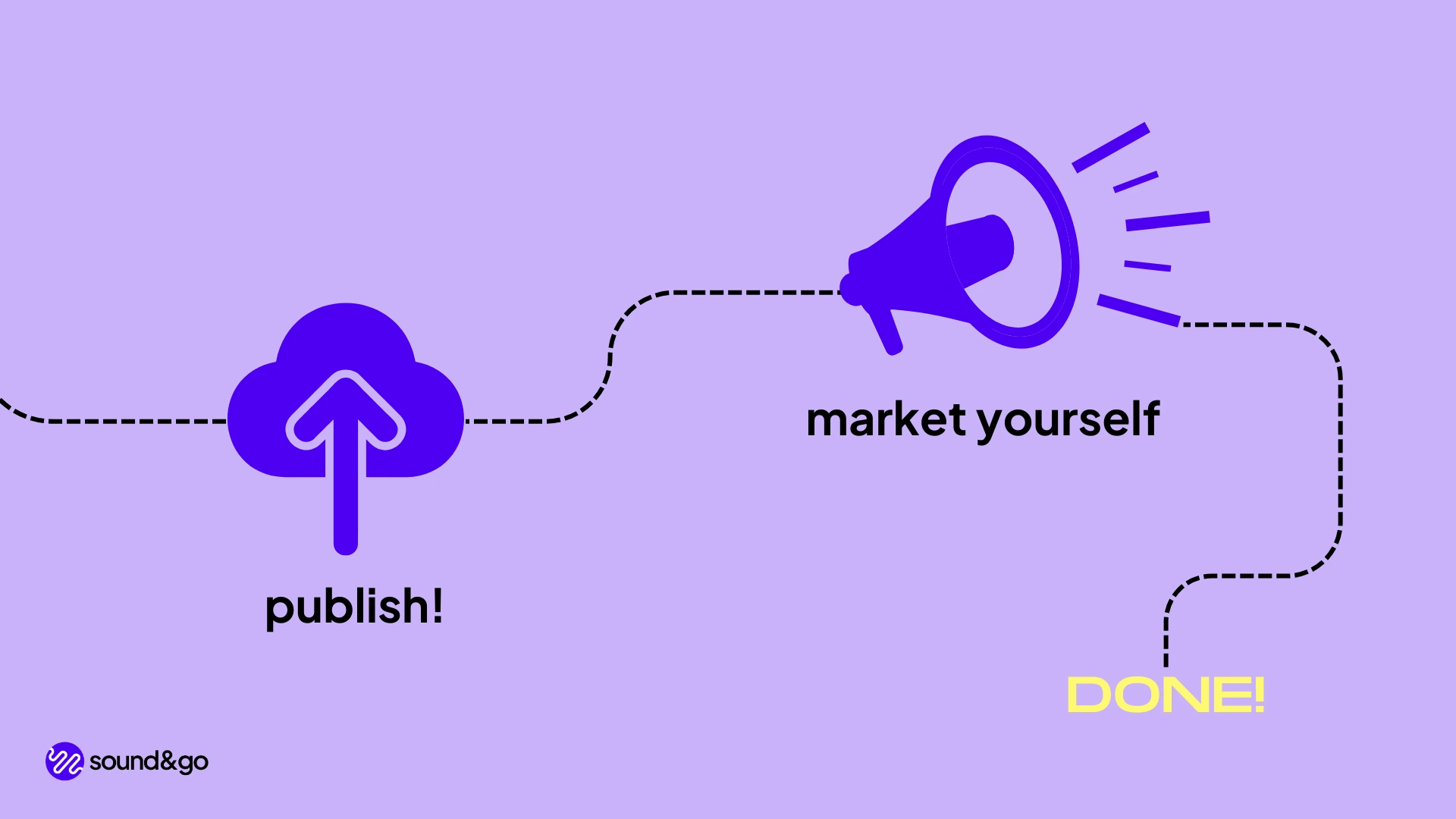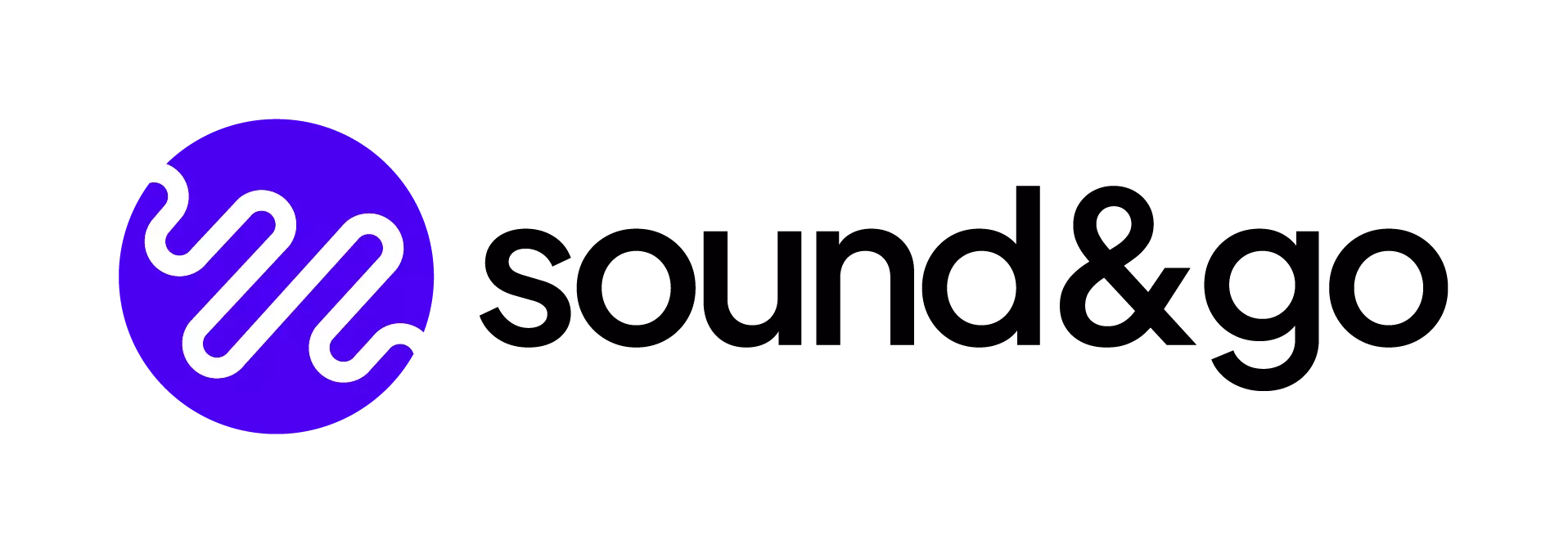Create your own podcast: learn how to start a podcast in 2025 in 10 steps - podcasting made easy
In this guide, we explain how you can easily create your first podcast. From concept to upload!

Start a podcast in 10 steps: Our step-by-step podcasting guide to create your own podcast episode
We want to help you create your own podcast. Our 10 steps will guide you quickly and easily from concept to finished podcast on Spotify!
Step 1: Define a topic, goal and basic conditions
You absolutely need a topic for a podcast. This topic should be well chosen, because all future podcast episodes will revolve around it. You also need to build your podcast as your own brand that is tailored to the podcast topic! More on this in step 4.
You should also be clear: Why am I doing this podcast? What do I want to achieve? How realistic is it that I can achieve this goal?
For example: Your goal is to be the biggest marketing podcast in Germany. You should be aware that there are already countless podcasts in this field! What makes you better? Do you have specific experience? Do you have the creativity to develop new formats? Are you an organizational talent? Do you have good contacts with people in this field?
Then you should start to think up formats or get inspired. How long should your podcast be? Should there be sections? Will there be interviews? Will there be sequences in the podcast, such as “Briefly explained” or “The 10 best…” to keep attention?
You should also be aware of the costs of podcasting. A low budget podcast is possible, but you need good planning!
Step 2: Define the audience for your new podcast - podcast topic
In order to reach people, you should first find out which audience your podcast will be of interest to. Is this podcast for entrepreneurs? For people who are interested in sustainability? How old is your target audience?
Once you have found a podcast audience, it is much easier to work out the concept better from here. The brand of your podcast also needs to be tailored to this group. After all, you want to “pick them up” and appeal to them right from the start. Only if you have a target group can you increase the number of podcast listeners to your show. This will help you to launch a successful podcast!

Step 3: Find a co-host and/or first guests
If you are really creative/popular or skilled enough to keep people listening to your podcast for a long time, then you can skip this step. However, the majority of podcasters will not record a pure solo podcast. For some, a co-host or co-host is already determined at the idea stage for a podcast.
You can find guests relatively easily via social media (LinkedIn is particularly useful here), as you can write a direct message to people from different fields. If you are somewhat active on LinkedIn, you can also quickly build up a small community and get to know new people.
However, there are also platforms to help you choose guests, for example podmatch or podcast guests. They let you find interesting people within your niche.
When you work with interview partners, there is always a certain risk that a person will cancel for whatever reason. To minimize this risk, you should make a plan and plan several episodes in advance. More on this in step 5.

Step 4: Create a brand with Podcast name, intro and podcast artwork - basis to your podcast marketing
Now that you have defined your target group, your concept and possibly co-hosts, you can start building your brand. We show you how to find your podcast title in our blog article, which should then be the basis for the cover! You should also think carefully about your name, because: Since podcast apps also have a search function, you can adapt the title to these “search engines”. It is therefore worth taking a closer look at the name.
You can create a podcast artwork using programs such as Canva, where there are already templates that you can use. These are super helpful, but make sure that your cover art is still unique and fits the topic. When designing your podcast cover, ask yourself the following question: What is my podcast about? What does it want to say and convey? Try to draw this thread through the brand.
This common thread should also be recognizable in the podcast intro. In the intro, you can make it clear in one sentence what your podcast is about. Podcasts usually start with an intro, so you should also create one (or have one created). However, you shouldn’t include more than the title, hosts and one sentence in the intro. This should also be short and concise so that it doesn’t take up too much space in your podcast episode and doesn’t become annoyingly long.
Step 5: Create a more detailed plan for future episodes
This is where it becomes very important, because good preparation can make your podcast significantly better. If guests realize that you are well prepared, they will tell you more, you can react better to answers and possibly get to hear one or two exclusive answers in your podcast.
You should also create a plan for how often and on which days you want to publish your podcast episodes so that your listeners can get into a rhythm and look forward to a new episode on a certain day of the week.
It is a good idea to create a more detailed plan for the next 3 weeks, the more the better. This way you can react to illnesses or other cancellations. You should also try to pre-produce your podcast episodes. This makes sense and is possible for some topics, but not for others. Because if you always want to discuss very current topics, you have to record shortly before publication.

Step 6: Set up your podcast equipment and find a suitable room
To create a podcast, you definitely need one thing: a good podcast microphone! There are an incredible number of microphones that you can use to record podcasts, so it’s easy to lose track. Many people prefer a USB microphone as you can get them up and running super quickly and without additional hardware. We also have an overview of good microphones in our blog!
But your equipment should include more than just a microphone. You should use headphones, especially in interview situations! You should have podcast recording and editing software, such as Audacity or Adobe Audition. These are just the basics! You can achieve a lot with minimalist equipment, but you will find that you can expand your equipment to create a better recording situation.
The recording situation also includes the room. You should definitely avoid recording your podcast in a reverberant room, because you can hear it and it impairs speech intelligibility. A room with a carpet, lots of curtains or similar thicker fabrics that avoid reverberation is better than a large open room. If necessary, it is always worth recording in a closet, as there is a lot of clothing hanging there, which reduces the reverberation.

Step 7: Record your podcast episode - podcast recording
Sounds easy: press “record” and start talking.
Of course, it’s not quite that simple. But because we’ve already done a lot of preparation during the creation process, we can now record in a more relaxed way. We also have a podcast checklist that you can tick off each time before recording to make sure you don’t forget anything important! This will make it easier for you to ensure a relaxed recording and good sound quality. This way you can minimize your workload. We also have a blog article just on the topic of podcast recording.
You will also need recording software or a recording device. All podcast editing software has a recording function! There are also Zoom recorders that you can plug a microphone into to record on the go. Or you use the most simple solution: The Røde Interview Pro. A microphone with a built-in recorder!
If you want to record your podcast remotely, you should check out our Article about it, we speak about Riverside.fm* and similar tools, as well as a free option!

Step 8: Edit your podcast
You will need the editing software mentioned above. You can of course use Audacity or Garageband (unfortunately not available for Windows) as free options.
There are also slightly more intuitive editing programs, but these are chargeable. If you want to edit your podcast yourself, you should also consider purchasing Adobe Audition, Cubase LE or similar software. These are compatible with Mac and Windows. This is a long-term investment, as it will take you a little longer to learn these programs at the beginning, but you can then use the editing program in such a way that you can use the additional features of better software.
Of course, you can also have your podcast edited externally; we also offer this service. This allows you to focus entirely on your content without compromising on audio quality.
Editing also includes the selection of podcast music, here you can use providers such as AudioJungle, Epidemic Sounds or similar, where “royalty free music” is available. More on this topic: Podcast music!

Step 9: Choose a podcast hosting service
Almost done! Your podcast episode is already finished, you just need to upload it to platforms such as Apple Podcasts, Spotify and co. Podcast hosting can help you with this. Here you upload your new episode and the podcast hosting platform submits your podcast to all podcast platforms (including via RSS feed). That sounds complicated, so let’s simplify it again:
In the podcast host you upload your audio file once, enter all data, such as title and show notes once and with one click you can distribute this data to all podcast providers. Of course, you should write the episode titles and show notes for this! A podcast hoster also takes care of loudness so that you don’t have to deal with terms like “LUFS”. So you need such a provider, at least with the most important functions. Because there is no direct upload button for Spotify, everything is done via podcast hosting.
We also have a comparison of the best podcast hosting providers, including Podigee and Spotify for Podcasters (formerly Anchor.fm), Libsyn and Buzzsprout. Check it out if you’re still looking! A comparison always helps, as most hosts are fee-based and the features differ. Some even offer a podcast website (yes, you should create a podcast website! You can easily include a podcast player). And Spotify for Podcasters offers free podcast hosting.

Step 10: Distribute your podcast - monetize your podcast - grow your podcast
The time has come! You have dared to start your first podcast! Your first episode is ready and available at every podcast location. So that you are not the only person who knows this, you should now start marketing your new podcast. It’s best to make a plan before you publish it. There are many different ways to generate more listeners for your podcast.
SEO, i.e. search engine optimization, also plays a role here; for example, you can use transcriptions of your podcast to write blog articles quickly and easily. If you do some SEO work, you can then be displayed at the top of Google with these articles.
You can create a social media profile and create lots of reels or audiograms (use repurpose.io and wavve.co to create little snippets of your podcast), you can become active on LinkedIn. You can also do classic PR and approach editors if you cover a current topic! Marketing is a huge topic (thats why there are so many podcasts about it 😉 )
The most important thing here is: don’t let go so quickly. Stay firm and find your way to promote your podcast.


Why do you want to start a podcast?
What are your reasons for creating a podcast? What are your goals? What makes you a good podcaster? As a host, you should ask yourself these questions, as this will be what drives you in the long term. Creating a podcast is not necessarily difficult, but making a good podcast successfully requires perseverance and motivation. Write down your motivation and look at your words again and again, they will motivate you in the long term!
Free podcast tools for creating a podcast
If you want to start a Podcast to see where it’s going, free podcast software is the way to go! In our article about podcast editing software you’ll find free alternatives, as well as good and cheap ones. Spotify for podcasters is also a hosting site which can put your podcast format on popular podcast directories like spotify for free. You can also record a podcast at spotify for podcasters or with the editing softwares for free. With Canva, you can also create your podcast cover art for free. You sure won’t be able to produce all your podcast content and your complete podcast for free, but you can try to keep the costs low with these tips.
Learn how to start making podcasts
Start a podcast! It’s the best time to do it! And it’s not even as hard as you might think. We have plenty of knowledge in our blog posts and you can always contact us if you have any questions or it you want us to help you with your technical questions.
A great podcast increases your reach!
Companies in particular are making more and more podcasts because it is “free” advertising. If you create interesting content as an entrepreneur, you can expand your customer base. You can do this, for example, with insights that customers would otherwise not hear. Depending on the company’s industry, the concept naturally plays an essential role here! The sub-topics of the podcast should be clearly communicated and should result in exciting content. No one wants to have to deal with podcasters who only speak boring advertising for 30 minutes. The listeners will also recognize this immediately and switch off.
How much money you could earn with your own podcast
Podcasting and earning money sounds great, doesn’t it? You will learn how you can really generate income with your own experience. In the beginning, you usually have a small reach, so many types of monetization are out of the question. We also show you how you can still earn money with podcast advertising, for example, in our blog. Earn money with podcasting yourself.
Yes – you can earn money with podcasts, many people are doing it! The most popular option is podcast advertising, i.e. you play an advertising clip in your podcast or record a text and are paid for it by the client. But there are other models for generating income, such as subscriptions for exclusive content, merch, coaching or other helpful paid offers. Yes, podcasts make money, you should think about monetizing your podcast.
Conclusion: You need to start a podcast in 2025
You are ready to launch your podcast to spotify and see how the people like it! But beware: A great podcast needs some time to become a popular podcast. Running a podcast is about evolving, podcast advertising and marketing. Share your podcast and see how it goes! Good luck!
Starting a podcast can be relatively easy if you have a little knowledge in this area. With good preparation, you can publish your first podcast in just a few weeks! As you can see, we have blog articles on many topics, and we also have an online course where you can learn how to record and edit a podcast. From how to create free audiograms to the definition of podcasts or finding a good podcast mic our podcasting articles are all about one thing: helping you.
Is podcast editing or the technical effort too much for you? Send us a request and we’ll see how we can help you. Have fun podcasting!
Links marked with * are affiliate links. There are no additional costs for you, some of these links are with an automatic discount for you. We mark these links for transparency and would never recommend bad products. Find out more here: Our partners.



